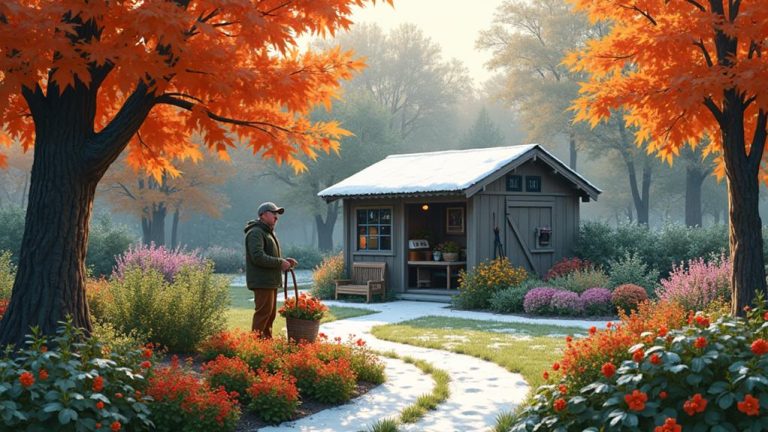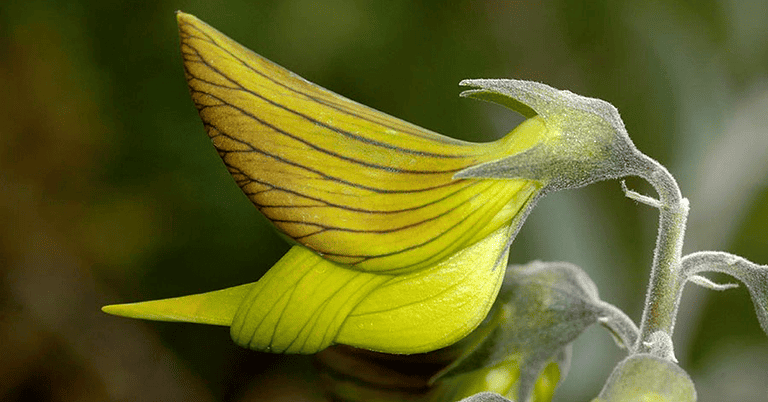Best Bee Plants for Your Pollinator Garden
You’ll want to plant native bee favorites like purple coneflower, bee balm, and black-eyed Susan since they’ve co-evolved with local bees for thousands of years, creating those special relationships that exotic plants just can’t match. Group these flowering beauties together in visible blocks, and don’t forget early bloomers like crocus, summer champions like lavender, and fall stars like asters to keep the buffet open all season long – your buzzing garden guests will reward you with incredible pollination magic that’ll make your neighbors wonder how you became such a green-thumbed wizard.
Quick Guide
- Choose native plants like bee balm, yarrow, and lavender that provide continuous nectar and pollen throughout growing seasons.
- Group flowering plants together in visible blocks to attract bees more effectively and maximize foraging efficiency.
- Select plants with staggered bloom times from early spring crocus to fall asters ensuring year-round food availability.
- Include diverse flower shapes and sizes to accommodate different bee species’ feeding preferences and foraging behaviors.
- Combine perennial plants for long-term stability with annual varieties to enhance seasonal diversity and habitat complexity.
Top Flowering Plants That Bees Love Most
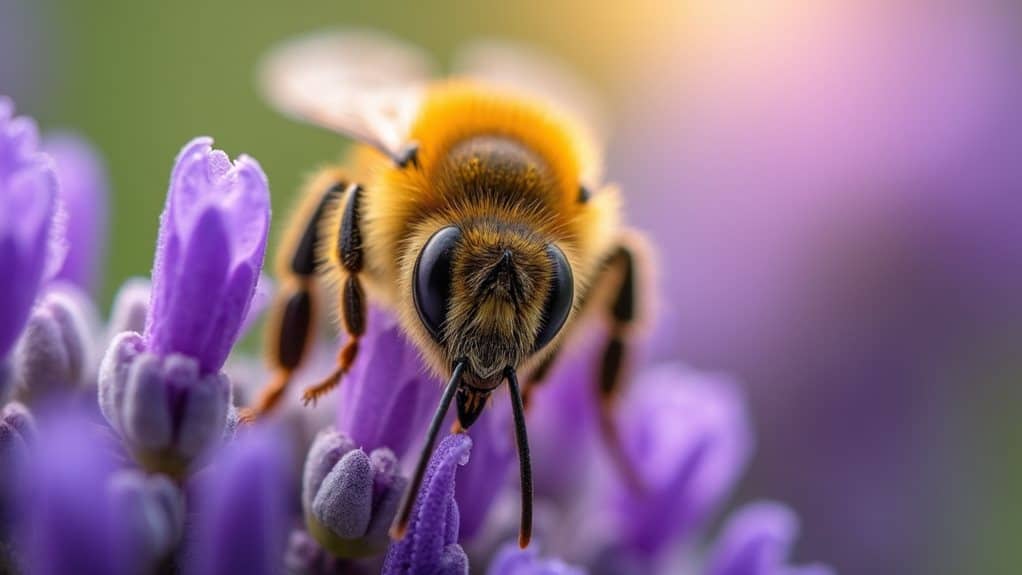
When you’re planning your pollinator garden, think of yourself as setting up the ultimate bee buffet – and trust me, these buzzing little guests have some pretty strong opinions about what makes their ideal dining experience!
You’ll want to roll out the red carpet with bee balm’s bright tubular flowers, yarrow’s accessible pollen smorgasbord, and lavender’s long-lasting nectar. Planting native species is crucial for the success of your garden, as it ensures that you attract local bee populations and support biodiversity. The best foundation for any successful bee garden starts with researching local native plants that will provide the most reliable food sources for your area’s specific bee populations.
Native Plants Essential for Pollinator Success
While those popular garden favorites like bee balm and lavender are absolutely fantastic choices, the real revolutionaries for your pollinator paradise are the native plants that have been throwing the ultimate neighborhood block party with local bees for thousands of years! These co-evolved partnerships create specialized relationships that you simply can’t replicate with exotic imports from distant continents. Native plants develop deep root structures that naturally prevent soil erosion while creating stronger, more resilient garden ecosystems. Additionally, these plants provide essential food sources such as nectar and pollen that are crucial for the health of beneficial insects.
Strategic Planting Techniques for Maximum Bee Activity
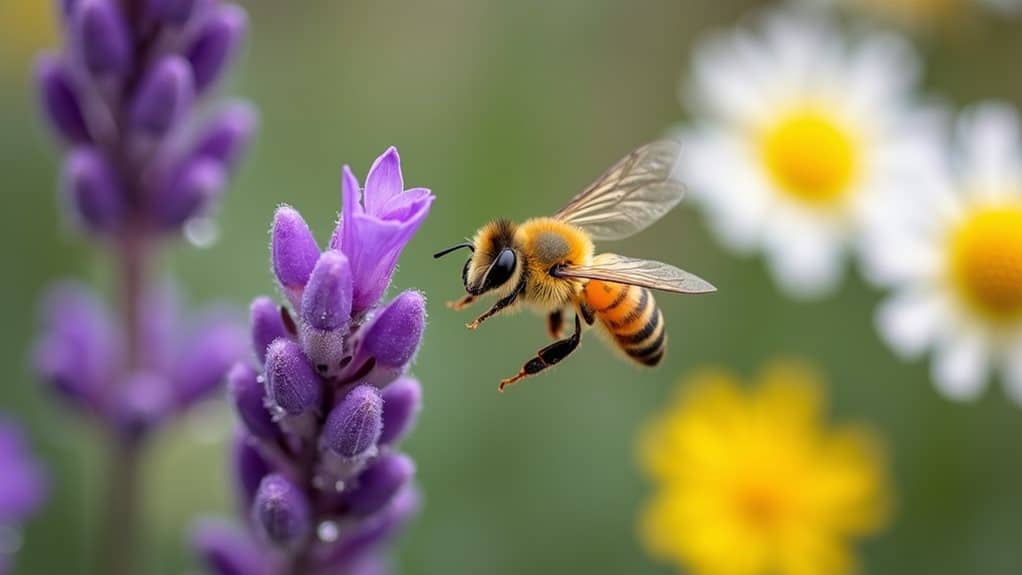
Since you’ve chosen your native plant champions and they’re ready to join your pollinator party, it’s time to hone the art of strategic placement that’ll turn your garden into the bee equivalent of an all-you-can-eat buffet with five-star service!
Plant at least one square yard of each species in sunny clusters, creating visible blocks that’ll have bees buzzing with excitement over your thoughtful hospitality. Additionally, incorporating native shrubs not only attracts bees but also supports the overall health of the local ecosystem.
Additional Bee-Friendly Flowers Worth Growing
Beyond the native superstars we’ve already covered, there’s a whole collection of additional flowering plants that’ll have bees doing backflips of joy in your garden, and honestly, some of these might just become your new favorites too!
Think aromatic bee balm with its summer fireworks, purple coneflowers standing tall like garden sentries, and zinnias blooming until frost hits.
Creating Shelter and Habitat for Pollinators
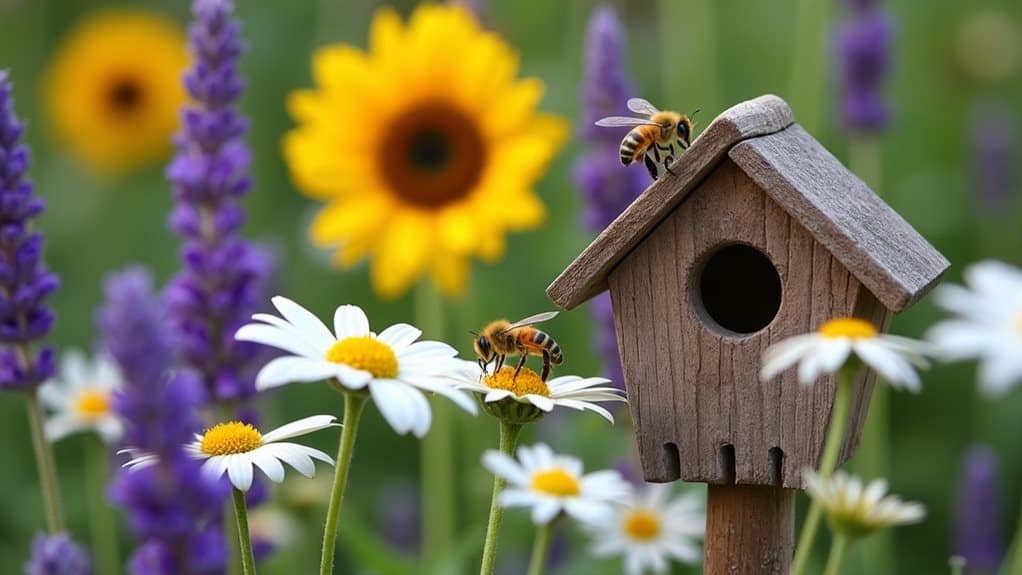
Although gorgeous flowers are the stars of your pollinator garden show, creating proper shelter and habitat is like building a five-star hotel where your buzzing guests can actually live, nest, and raise their families – and trust me, once you start thinking about your garden as a complete ecosystem rather than just a pretty flower display, you’ll uncover success.
Maintenance Tips for Thriving Pollinator Plants
Once you’ve planted your pollinator paradise, you’ll need to hone some essential maintenance techniques to keep those busy bees happy and your garden blooming like a champion throughout the seasons.
Proper pruning and deadheading aren’t just fancy gardening terms—they’re your secret weapons for encouraging more flowers, extending bloom periods, and creating that snapshot-perfect pollinator haven you’ve been dreaming about since you first imagined butterflies dancing through your backyard.
Native plants might seem low-maintenance (and they’re compared to their fussy non-native cousins), but they still need your attention and care to truly thrive, especially during those critical first couple of years when they’re establishing their root systems and figuring out their new home.
Pruning and Deadheading Techniques
While creating a pollinator paradise in your backyard might seem like the kind of low-maintenance gardening quest that practically takes care of itself, you’ll actually need to command a few key pruning and deadheading techniques to keep your bee-friendly plants thriving and blooming their little hearts out all season long.
Cut back woody vines by half in early spring, then trim by one-third throughout spring to control growth.
Native Plant Care
Native plants might be the hardy champions of the pollinator world, but even these resilient beauties need some thoughtful TLC to truly flourish and support your buzzing garden visitors throughout the seasons.
Water them deeply 1-2 times weekly during their first year, apply mulch around their base, and stay vigilant about weeding—your bees will absolutely thank you!
Seasonal Blooming Strategies for Year-Round Support
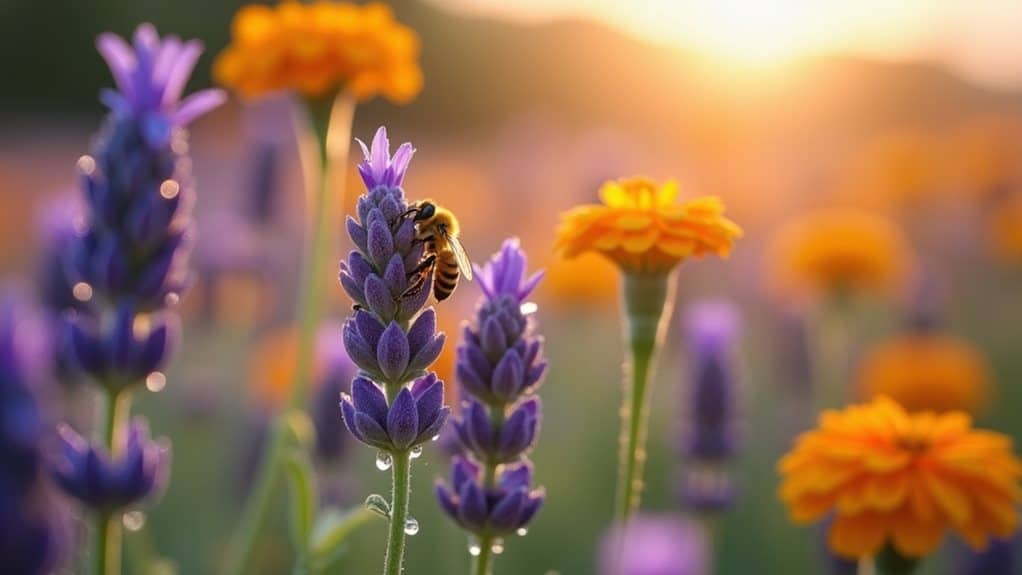
Creating a pollinator paradise that buzzes with activity from the first warm days of spring through the final frost of autumn requires strategic planning that’s honestly more exciting than plotting your next camping excursion – and trust me, I get pretty fired up about finding the perfect campsite!
You’ll want early bloomers like crocus and serviceberry, summer stalwarts including purple coneflower and bee balm, plus fall champions like asters and goldenrod for continuous nectar availability.
Water and Soil Requirements for Bee Gardens
You’ve picked incredible plants that’ll have bees buzzing with excitement, but here’s the thing – even the most gorgeous bee-friendly flowers won’t thrive if you don’t get the soil and water conditions just right!
Think of it like setting up the perfect campsite: you wouldn’t pitch your tent in a swampy area or forget to bring clean water, and your pollinator garden needs that same level of thoughtful preparation to create a five-star bee resort.
Let’s investigate how proper soil drainage, smart watering techniques, and the right amendments can alter your garden into a thriving ecosystem that keeps both plants and pollinators happy all season long.
Optimal Soil Conditions
While you might think any old dirt will do for your pollinator garden, the truth is that bees are surprisingly picky about their real estate preferences – and honestly, can you blame them?
You’ll want loamy soil that drains well but stays moist, mixed with compost in a 50-50 ratio for the perfect bee-friendly foundation.
Watering Best Practices
Just as you wouldn’t head out on a camping trip without packing enough water bottles, your buzzing garden visitors need their own reliable hydration stations to keep their colonies thriving and healthy.
Set up shallow containers with rocks for landing spots, refresh daily, and place them near your flowering plants for maximum bee convenience.
Drainage and Amendments
Because even the most spectacular wildflower meadow can’t flourish in soggy, waterlogged soil, creating the perfect drainage system becomes your secret weapon for converting any backyard space into a thriving pollinator paradise.
You’ll want to work 2-3 inches of compost into your top soil layer, building raised beds if you’re dealing with stubborn clay that drains slower than camping coffee.
Organic Practices to Protect Pollinator Health
When you’re creating your pollinator garden, adopting organic practices isn’t just a trendy choice—it’s absolutely essential for protecting the health of bees, butterflies, and other beneficial insects that’ll make your outdoor space thrive.
You’ll avoid synthetic pesticides that harm guidance and immunity, while providing diverse flowering plants that offer continuous, nutritious food sources throughout growing seasons.
Wrapping Up
You’ve got all the tools now to convert your backyard into a buzzing bee paradise that’ll make your neighbors wonder what magical pollinator potion you’ve found! Remember, creating the perfect bee garden isn’t just about pretty flowers—you’re literally helping save these incredible little workers who keep our world blooming. So grab your gardening gloves, get those hands dirty, and watch as your garden becomes the neighborhood’s hottest bee hangout spot this season!



